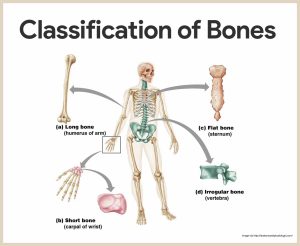Bone Physiology – outline notes
Call Us Now
Get the Best CPR Class in St. Louis Today!

I. Basic Functions of Bones
A. support – shape and form
B. storage – minerals (Ca2+, PO43-) and lipids (yellow bone marrow)
C. blood cell production – red bone marrow
D. protection
E. movement
II. Classification of Bones
A. Shape
1. Long, short (carpals), flat (sternum), irregular (vertebrae)
2. Proportions of osseous tissue
a. Compact / Dense Bone
b. Spongy / Cancellous Bone
3. Bones are organs
a. Osseous tissue, fibrous tissue C.T., cartilage, nervous, vessels
III. Gross Structure of Long Bones
A. Diaphysis – shaft
1. Thick collar of compact bone
2. Medullary cavity – yellow bone marrow
B. Epiphysis – ends
1. Compact bone forms exterior
2. Spongy bone forms interior – red bone marrow
3. Articular cartilage
4. Epiphyseal line – b/t diaphysis and epiphysis –adult bones
a. Epiphyseal plate – where bones grow (hyaline cartilage)
C. Membranes associated with bones
1. Periosteum – double membrane covering diaphysis
a. Fibrous layer – dense irregular C.T. (outer); attach to tendons and ligaments
b. Cellular layer (osteogenic layer) 1) Osteoblasts – osteogenesis
2) Osteoclasts – from monocytes
a) Osteolysis (resorption) – osteoclasts release acids and proteolytic enzyme (collagenase)
2. Endosteum – lines cavities
a. Cellular layer – osteoblasts and osteoclasts
3. Hematopoietic tissue – source of blood cells (-poiesis – making)
a. Red Bone Marrow
b. Location – adults
1) Head of femur and humerus
2) Sternum and hip bones ——> *site for samples
IV. Microscopic structure of bones
A. Compact Bone
1. Osteons
2. Central canal – vessels and nerves
3. Lamellae – layers of bone
4. Osteocyte – mature bone cell; from osteoblasts
a. Located in lacuna
b. Dissolves matrix to release minerals (Ca2+) into blood
c. Can revert back to osteoblast when repair is needed
5. Canaliculi – tiny canals; allow for exchanges b/t osteocytes
6. Volkmanns canals – canal at right angles to central canals; vessels
B. Spongy Bone
1. Trabeculae
2. Red bone marrow
3. Flat bone
a. Diploe – spongy bone sandwiched between compact bone
Call Us Now
Get the Best CPR Class in St. Louis Today!
V. Chemical composition of bone
A. Inorganic – 2/3
1. Ca3(PO4)2 + Ca(OH)2 —– Ca10(PO4)6(OH)2
calcium phosphate + calcium hydroxide — hydroxyapatite
2. Hardness of bone (vinegar)
B. Organic – 1/3
1. Osteoid
a. Collagen fibers, organic molecules
2. Strength – flexibility and resists stretching and twisting (baking)
VI. Bone development – ossification / osteogenesis
A. Embryo – at six weeks composed of fibrous and cartilage structures
B. Two forms of ossification (bone development)
1. Intramembranous ossification – from mesenchyme or fibrous membrane (dermis) (dermal or membrane bone)
2. Endochondral ossification – bone replaces existing hyaline cartilage (cartilage bone)
VII. Growth of long bones
A. Long bones lengthen at epiphyseal plate (hyaline cartilage)
B. Cessation of growth (18 females – 21 males)
1. Epiphyseal plate closure
a. Hyaline cartilage is replaced by bone; epiphyseal line
VIII. Normal Bone Growth and Maintenance
A. Calcium and phosphate salts
B. Vitamin D (cholecalciferol)
1. Necessary for production of calcitriol in kidney
2. Calcitriol necessary for absorption of calcium and phosphates at small intestine.
C. Vitamin C
1. Collagen synthesis
2. Scurvy – vitamin C deficiency, weak connective tissue, bones
D. Hormones
1. Growth Hormone – anterior pituitary
2. Thyroid Hormone – thyroid gland
3. Parathyroid Hormone – parathyroid glands
4. Calcitonin – thyroid gland
IX. Growth of Bones is under Hormonal Control
A. Pathway
Hypothalamus —–> Growth hormone releasing hormone (GHRH) —–> —–> Anterior Pituitary —–> Growth Hormone (GH) ——>Liver ——> —–>:Somatomedins (insulin-like growth factor) ——-> Bone Growth
B. Growth Hormone (GH) Disorders
1. Gigantism – hypersecretion of GH in children
2. Dwarfism – hyposecretion of GH in children
3. Acromegaly – hypersecretion of GH in adults
X. Calcium Balance is Under Hormonal Control
A. Calcium is necessary for most things
1. Nerve transmissions, muscle contractions, cell division, cell communication, blood coagulation, gland secretions, etc.
B. Organs involved
1. Kidneys
2. Bones
3. Thyroid gland
4. Parathyroid gland
5. Small Intestines
C. Hormones involved
1. Parathyroid Hormone (PTH) – parathyroid gland
2. Calcitonin – thyroid gland
D. Negative Feedback systems in control of Calcium levels
XI. Bone Remodeling = bone deposit + bone resorption
A. Bone is dynamic; recycle throughout life
B. Bone deposit
1. Osteoblasts secrete osteoid —-> then osteoid is calcified to make bone
2. Occurs with normal bone remodeling
3. Increases with injury or where strength is needed
C. Bone resorption
1. Osteoclasts
D. Bone remodeling occurs in the following sequence
*2-3 weeks of bone resorption phase followed by a 2-3 week of bone formation
E. Osteoporosis occurs when bone resorption outpaces bone deposit
F. Stress on bones (such as with weight bearing exercise) increases osteoblast activity and thickens bones






